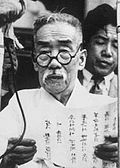President
In order to be elected, a candidate had to receive at least two-thirds of the votes cast, including blank and invalid ballots. While there were 198 members in the National Assembly, 196 members participated in the voting. Therefore, the number of votes needed to win the presidency was 131.
Even though Kim Ku did not send his approvals for the new South Korean government and insisted that the lawmakers not cast votes for him, 13 of the 196 lawmakers who voted voted for Kim Ku. The election, however, ended as a landslide victory of the only candidate that actively sought the presidency, Rhee Syng-man, who received 180 of the 196 votes cast. One vote was invalidated, as it was cast for independence activist Seo Jae-pil, who at the time was a US citizen.


